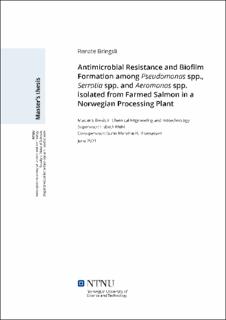| dc.contributor.advisor | Mehli, Lisbeth. | |
| dc.contributor.advisor | Thomassen, Gunn Merethe. | |
| dc.contributor.author | Bringsli, Renate. | |
| dc.date.accessioned | 2021-09-25T16:16:10Z | |
| dc.date.issued | 2021 | |
| dc.identifier | no.ntnu:inspera:80861898:16735970 | |
| dc.identifier.uri | https://hdl.handle.net/11250/2782672 | |
| dc.description.abstract | Norge er en verdensledende produsent av oppdrettslaks, noe som innebærer at norsk lakseindustri har et stort ansvar når det kommer til levering av sunne og trygge produkter som eksporteres verden over. Nå som antibiotikaresistente bakterier har blitt en anerkjent trussel mot matsikkerhet og folkehelse, er det behov for en grundig kartlegging av status, utvikling og diversitet av resistens hos bakterier i norsk sjømat. Denne masteroppgaven er et bidrag til dette arbeidet, ettersom antibiotikaresistens undersøkes hos Pseudomonas-, Serratia- og Aeromonas-slekten isolert fra oppdrettslaks i et norsk lakseslakteri. Siden bakteriell biofilm er en stor utfordring for sjømatindustrien, ble biofilmdannelsen hos disse bakteriene undersøkt ved driftstemperaturen hos norske lakseslakteri (12°C). Effektiviteten av Aqua Des Foam PAA ble også testet, ettersom dette desinfeksjonsmiddelet brukes til desinfeksjon av utstyr og overflater i lakseslakteri.
En diskdiffusjonstest viste at 36.2% av bakteriene var resistent mot ampicillin, 6.4% mot florfenicol og 4.3% mot tetrasyklin, og et brønneplateforsøk for testing av følsomhet illustrerte at MIC og MBC verdiene til florfenicol var henholdsvis 19 – 300 μg/mL og 75 – 2400 μg/mL. Disse resultatene viser et lavt nivå av antibiotikaresistens sammenlignet med andre lakseindustri-nasjoner slik som Chile. De observerte tilfellene av antibiotikaresistens i denne masteroppgaven ser heller ut til å skyldes iboende mekanismer enn tilegnelsen av resistensgener grunnet antibiotikabruk i norsk lakseoppdrett. En PCR-basert påvisning av gener knyttet til antimikrobiell resistens viste at ingen av bakteriene hadde verken ampC, bcrABC, floR, sul1, tetG, qac∆E1 eller qacH genet. Den påviste resistensen skyldes derfor andre gener og assosierte mekanismer enn disse genene.
Et biofilm brønneplateforsøk viste at Pseudomonas spp., og spesielt P. fluorescens, var en effektiv biofilm-produsent ved 12°C, og disse bakteriene er derfor av ekstra stor bekymring hos lakseslakteri. Desinfeksjonsprosedyren med Aqua Des Foam PAA som anvendes av lakselakteriet var tilstrekkelig for å drepe planktoniske celler, mens over 10% av biofilm- cellene overlevde desinfeksjonen. For å unngå at overlevende bakterier potensielt tilegner seg en økt toleranse mot desinfeksjonsmiddelet grunnet gjentatt eksponering, bør brukskonsentrasjonen av Aqua Des Foam PAA økes. | |
| dc.description.abstract | As Norway has become the world ́s largest producer of farmed salmon, the Norwegian salmon industry has a large responsibility to provide microbially safe and healthy products to consumers worldwide. Now that antimicrobial resistant bacteria are recognized as an emerging threat to food safety and public health, a comprehensive mapping of the occurrence, evolution and diversity of antimicrobial resistance in bacteria associated with Norwegian seafood is needed. This master study contributes to this work, as the resistance status of Pseudomonas spp., Serratia spp., and Aeromonas spp. isolated from farmed salmon in a Norwegian processing plant is illuminated. As bacterial biofilms pose a serious challenge to the seafood industry, the biofilm formation among these bacteria was tested at the operating temperature of salmon processing plants (12°C). The efficiency of Aqua Des Foam PAA was also tested, as it is commonly applied to disinfect surfaces and equipment in salmon processing plants.
A disk diffusion assay revealed that 36.2% of the bacteria were resistant to ampicillin, 6.4% to florfenicol and 4.3% to tetracycline, and a microtiter susceptibility assay showed that florfenicol MIC- and MBC values ranged from 19 – 300 μg/mL and 75 – 2400 μg/mL, respectively. This demonstrate a low occurrence of antibiotic resistance compared to other main seafood producing countries such as Chile. The observed incidences of resistance in this master study are likely caused by intrinsic mechanism rather than acquisition of resistance genes caused by antibiotic usage in Norwegian salmon farming. The PCR-based detection of antimicrobial resistance genes revealed that none the bacteria possessed either the ampC, bcrABC, floR, sul1, tetG, qac∆E1 or the qacH gene. Thus, the observed incidences of resistance are caused by mediators other than these resistance genes.
A microtiter biofilm assay illuminated that Pseudomonas spp. and particularly P. fluorescens were efficient biofilm producers at 12°C, and are therefore of particular concern to the processing plants. The commonly applied Aqua Des Foam PAA disinfection procedure was sufficient to eradicate all planktonic cells, while more than 10% of biofilm cells survived the disinfection. To avoid surviving bacteria potentially acquiring an increased tolerance to the disinfectant caused by repeated exposure, the usage concentration should be increased. | |
| dc.language | eng | |
| dc.publisher | NTNU | |
| dc.title | Antimicrobial Resistance and Biofilm Formation among Pseudomonas spp., Serratia spp. and Aeromonas spp. isolated from Farmed Salmon in a Norwegian Processing plant | |
| dc.type | Master thesis | |
